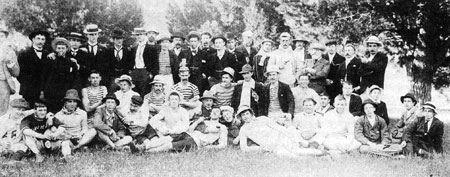History of Barwon Rowing Club
Chapter 5 - The Heroes of Old 1901-1919

Barwon Rowing Club Opening Day Picnic Queen's Park 1900
In the first year of the new century, Stephen Fairbairn, who had always taken a keen interest in Barwon, donated a double and two single sculls to the club. In nominating him as an honorary life member in thanks, the president spoke of the great interest the club had in his career, as he had to learned to row on the Barwon under the able tuition of the vice-president, J. L. Cuthbertson. Fairbairn went on to become one of England's legendary rowing coaches and initiator of the "Fairbairn" style of rowing. On a more sombre note, the club noted with pride the departure of Carstairs, Philpott, Barr and Wilson to the Boer War in South Africa, and hoped that they would soon see them fighting in a milder form for the old club on the river. Membership increased steadily and began to include a second generation of rowers from the Austin, Bostock, Brearley, Douglass, Collins, Fairbairn, Guthrie, Pearson, Shannon and Strachan families. Competing for the club at the turn of the century were the four sons of one of the club's founders, Archie, Eliot, Ford and Herbert Shannon. Their mother was Emily Strachan, sister to the Strachan brothers who were amongst the club's first rowers.
Over the next few years, extensions and improvements were made to the boatshed. In 1902 a separate shed was built for the pleasure boat, in 1906 a special shed for the eights and by 1907, the facilities for 55 members included dressing rooms with cold showers and toilets. This year saw the introduction of a blazer to the club uniform. It was dark blue with an embroidered pocket of the club's flag and crossed oars and worn with a blue and white striped guernsey, white flannel trousers and a blue cap with club flag.
In 1905 a joint committee from the Barwon Regatta and the Geelong Progress Association initiated a scheme for the improvement of the north bank of the river in front of Barwon's sheds. This eventually went ahead as an unemployed relief committee scheme. At the time the rowing reserve was said to be both unsightly and neglected, with the large open sewer running from Moorabool Street to the river and entering to the west of Barwon's sheds, said to be a foul-smelling drain. A new landing stage in front of the sheds was built and a high galvanised iron fence with gates on the extension of Yana Street on the west side. Seats for lady spectators were also provided on both sides of the bridge. At the time the finish of the course was at the foot of Yarra Street, the course being 1 mile and 380 yards. The judges' tent was located on the south bank of the river although their view was often obscured by the many carriages and traps that followed the races along the bank. In 1907 a bandstand was built in the reserve and it provided a welcome stage for St. Augustine's Band at that year's regatta. The bandstand was considered a good idea after the members of St. Augustine's Band, when entertaining the crowds at a 1906 River Carnival Fete, had become waterlogged to their ankles when performing upon a makeshift timber platform lashed to four casks.
In 1909 the club bought another eight, completely funded by the members. The boat would have been of the "best and best" type, carvel built. Swivel rowlocks for eights and fours were just being adopted although the more conservative forces still favoured the fixed thole pin. All boats in Australia by this time were centre seated, although the English still sat staggered. Presumably the new best and best was used at the 1910 Bairnsdale Regatta.A Maiden four of S. Barnfather, E. Shannon, H. Riordian and H. McCallum with a Maiden eight of S. Smith, O. Batten, L. Stoner, C. White, J. David, H. Roadknight, A. Collins and H. Knight accommpanied by the club's coxswain, Pat Hardiman and coached by W. Pincott set out on a pleasurable trip, an account of which, written by a club member under the pen name of "One of the Eight" was published in the Geelong Advertiser.
